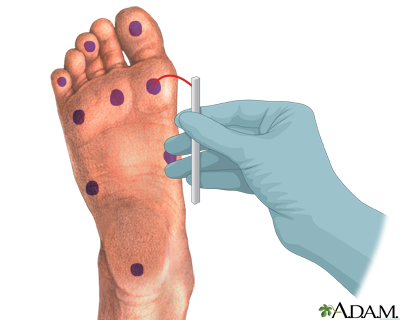Pregnancy SmartSiteTM
Routine diabetes tests; Diabetes - prevention DescriptionPeople who take control of their own diabetes care by eating healthy foods, living an active lifestyle, and taking medicines as prescribed often have good control of their blood sugar levels. Still, regular health checkups and tests are needed. These visits give you a chance to:
See Your DoctorSee your diabetes provider every 3 to 6 months. During this visit, your provider should check your:
See your dentist every 6 months, also. If you are taking insulin or other injections, your provider will also examine your skin to look for signs of reactions to insulin at your injection sites. These may be hard areas or areas where fat under the skin has formed a lump. Your provider may also check your abdomen for signs of an enlarged liver. Eye ExamsAn eye doctor (ophthalmologist or optometrist) should check your eyes every year. See an eye doctor who takes care of people with diabetes. If you have eye problems because of diabetes, you will probably see your eye doctor more often. Foot ExamsYour provider should check the pulses in your feet and your reflexes at least once a year. Your provider should also look for:
If you have had foot ulcers before, see your provider every 3 to 6 months. It is always a good idea to ask your provider to check your feet. Hemoglobin A1C TestsAn A1C lab test shows how well you are controlling your blood sugar levels over a 3-month period. The normal level is less than 5.7%. Most people with diabetes should aim for an A1C of less than 7%. Some people have a higher target. Your provider will help decide what your target should be. Higher A1C numbers mean that your blood sugar is higher and that you may be more likely to have complications from your diabetes. CholesterolA cholesterol profile test measures cholesterol and triglycerides in your blood. You should have this kind of test in the morning, after not eating since the night before. Most adults with type 2 diabetes should have this test once a year. People age 40 or over with high cholesterol or on medicines to control their cholesterol may have this test more often. Blood PressureBlood pressure should be measured at every visit. Talk to your provider about what your blood pressure goal should be. Kidney TestsOnce a year, you should have a urine test that looks for a protein called albumin. Your provider will also have you take a blood test every year that measures how well your kidneys work. ReferencesAmerican Diabetes Association Professional Practice Committee. 4. Comprehensive medical evaluation and assessment of comorbidities: Standards of Care in Diabetes-2024. Diabetes Care. 2024;47(Suppl 1):S52-S76. PMID: 38078591 pubmed.ncbi.nlm.nih.gov/38078591/. Brownlee M, Aiello LP, Sun JK, et al. Complications of diabetes mellitus. In: Melmed S, Auchus RJ, Goldfine AB, Koenig RJ, Rosen CJ, eds. Williams Textbook of Endocrinology. 14th ed. Philadelphia, PA: Elsevier; 2020:chap 37. Centers for Disease Control and Prevention website. Your diabetes care schedule. www.cdc.gov/diabetes/treatment/your-diabetes-care-schedule.html. Updated December 19, 2023. Accessed May 30, 2024. Dhatariya KK, Umpierrez GE, Crandall JP. Diabetes mellitus. In: Goldman L, Cooney KA, eds. Goldman-Cecil Medicine. 27th ed. Philadelphia, PA: Elsevier; 2024:chap 210. | ||
| ||
Review Date: 5/20/2024 Reviewed By: Sandeep K. Dhaliwal, MD, board-certified in Diabetes, Endocrinology, and Metabolism, Springfield, VA. Also reviewed by David C. Dugdale, MD, Medical Director, Brenda Conaway, Editorial Director, and the A.D.A.M. Editorial team. View References The information provided herein should not be used during any medical emergency or for the diagnosis or treatment of any medical condition. A licensed medical professional should be consulted for diagnosis and treatment of any and all medical conditions. Links to other sites are provided for information only -- they do not constitute endorsements of those other sites. No warranty of any kind, either expressed or implied, is made as to the accuracy, reliability, timeliness, or correctness of any translations made by a third-party service of the information provided herein into any other language. © 1997- A.D.A.M., a business unit of Ebix, Inc. Any duplication or distribution of the information contained herein is strictly prohibited. | ||


 Monofilament test
Monofilament test
